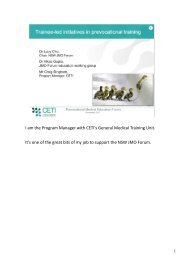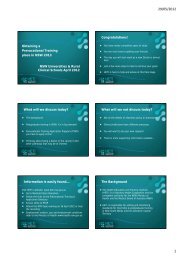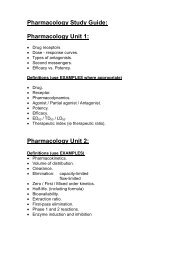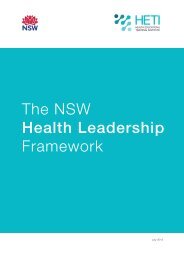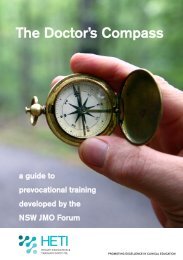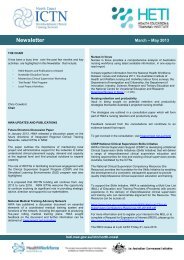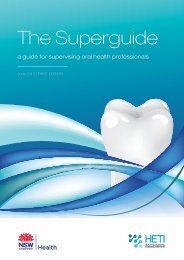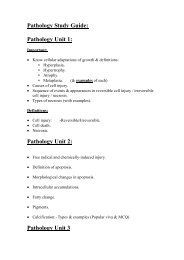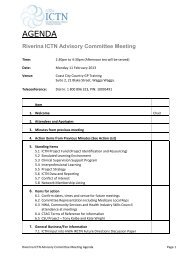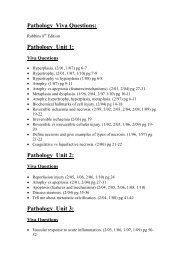a handbook for supervising allied health professionals - HETI - NSW ...
a handbook for supervising allied health professionals - HETI - NSW ...
a handbook for supervising allied health professionals - HETI - NSW ...
You also want an ePaper? Increase the reach of your titles
YUMPU automatically turns print PDFs into web optimized ePapers that Google loves.
THE SUPERGUIDE<br />
Formal teaching<br />
58<br />
As a senior clinician, you may be required to give in-service training and presentations,<br />
and the one clear advantage is that your subject will probably match your expertise.<br />
Practice these tips to make your presentations effective:<br />
• Consider your audience and shape your material to make it relevant to their current<br />
knowledge, clinical responsibilities and objectives. If in doubt, consider using<br />
questions at the start of your presentation to establish where to pitch your talk.<br />
• The first five minutes are vital. Capture interest with a compelling start (why should<br />
the audience listen) and explain what you intend to cover in your talk. If you have<br />
one key point above all, make it early.<br />
• When using PowerPoint slides, don’t dump all the in<strong>for</strong>mation on the slide. White<br />
space, use of images and uncluttered slides with few words will ensure the<br />
audience pays attention to what you are saying.<br />
• Don’t read your presentation — most of all, don’t read your PowerPoint slides. Talk<br />
to your audience and maintain eye contact.<br />
• Stories, jokes and analogies are useful tools to make facts memorable.<br />
• Respond to visual cues from the audience to change pace. Ask a question if you are<br />
not sure that the audience is with you.<br />
• Vary your delivery and technique. Consider breaking the presentation with questions<br />
to or from the audience, or an activity to be carried out by the learners.<br />
• Close your presentation strongly, with a summary of what you hope the audience<br />
will take away.<br />
• Avoid overstuffing your presentation with material. It is better to be succinct and<br />
cover key points than trying to teach everything in one session.<br />
• Obtain feedback in order to evaluate the effectiveness of your teaching and make<br />
improvements next time.<br />
Beyond the in-service<br />
Don’t <strong>for</strong>get the broad spectrum of teaching methods available to you as a teacher<br />
as alternatives or adjuncts to providing in-services:<br />
• simulations and role plays<br />
• videos to demonstrate techniques or behaviours<br />
• group discussions, case studies and problem-based learning<br />
• computer-based education.<br />
These subjects go beyond what can be covered in this book — so explore. Even<br />
the simplest departures from the standard in-service <strong>for</strong>mat will make the content<br />
of your education sessions more memorable.



